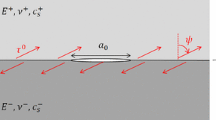Conclusions
Many problems of the theory of elasticity with the mixed boundary conditions are characterized by the occurrence of singularities at the boundary of the change of the type of boundary conditions. The nature of these singularities depends on a number of parameters. The use of solutions of these problems in the fracture mechanics causes difficulties if traditional fracture criteria are employed. In [9] a zone of slipping was introduced in solving contact problems, and in [2, 16] this zone was introduced in problems of the crack at the interphase boundary of dissimilar media. This made it possible to eliminate the oscillating singularities. A singularity dependent on the friction coefficient resulted in these problems [9, 16] because dry friction was taken into account. The effect of limiting friction restores the singularity to 1/2, necessary for use of the traditional fracture criteria. In addition to this, a more realistic description of the interaction between the dissimilar materials, taking into account friction and the plastic properties, is of great importance for examining the processes of local fracture in composite materials.
Similar content being viewed by others
Literature cited
M. L. Williams, “The stress around a fault or crack in dissimilar media,” Bull. Seismol. Soc. Am.,49, 199–204 (1959).
M. Comninou, “The interface crack,” J. Appl. Mech.,44, 631–636 (1977).
B. M. Malyshev and R. L. Salganik, “The strength of adhesive joints using the theory of fracture,” Int. J. Fract. Mech., 414–428 (1965).
A. H. England, “A crack between dissimilar media,” J. Appl. Mech.,32, 400–402 (1965).
J. Dundurs, “Discussion,” J. Appl. Mech.,36, 650–652 (1969).
N. I. Muskhelishvili, “Solution of the basic mixed problem of the theory of elasticity of the half plane,” Dokl. Akad. Nauk SSSR,8, No. 2, 51–54 (1935).
N. I. Muskhelishvili, “Main boundary problems of elasticity theory for the half plane,” Soobshch. Akad. Nauk Gruz. SSR,2, No. 10, 873–880 (1941).
V. M. Abramov, “The problem of the contact of an elastic half plane with an absolutely rigid base taking into account friction,” Dokl. Akad. Nauk SSSR,18, No. 4, 173–178 (1937).
L. A. Galin, Contact Problems of Elasticity Theory [in Russian], Moscow (1953).
Composite Materials [Russian translation], Vol. 2, Moscow (1978).
J. Shiory and K. Inoue, “Micromechanics of interfacial failure in short fiber-reinforced composite materials,” in: Composite Materials, Reports of the First Soviet-Japanese Symposium on Composite Materials, Moscow (1979), p. 430.
L. V. Nikitin and A. N. Tumanov, “Analysis of local failure in a composite,” Mekh. Kompozitn. Mater., No. 4, 595–601 (1981).
N. I. Muskhelishvili, Some Main Problems of the Mathematical Theory of Elasticity [in Russian], 5th ed., Moscow (1966).
F. D. Gakhov, Boundary Value Problems, Pergamon (1966).
G. R. Irwin, “Analysis of stresses and strains near the end of a crack traversing a plate,” J. Appl. Mech.,24, 361–364 (1957).
M. Comninou, “Interface crack with friction in the contact zone,” J. Appl. Mech.,44, 780–781 (1977).
Author information
Authors and Affiliations
Additional information
Translated from Mekhanika Kompozitnykh Materialov, No. 1, pp. 20–25, January–February, 1983.
Rights and permissions
About this article
Cite this article
Zakharov, V.V., Nikitin, L.V. Effect of friction on the process of separation of dissimilar materials. Mech Compos Mater 19, 15–20 (1983). https://doi.org/10.1007/BF00604020
Received:
Issue Date:
DOI: https://doi.org/10.1007/BF00604020




